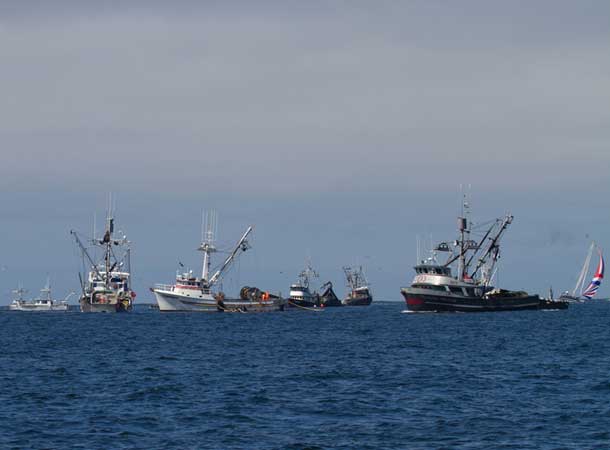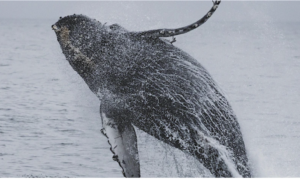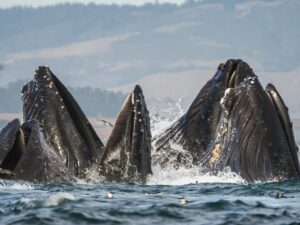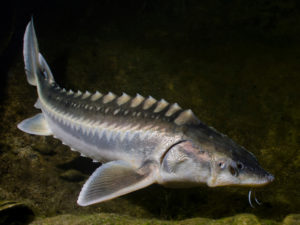They’re the little guys. Small, silver, nondescript fish that are so hard to tell apart that many people simply call them “baitfish.” But though they don’t command the attention of a breaching humpback whale or trophy tuna, these humble creatures known as forage species–from anchovies to squid–play a starring role in local marine ecosystems.
New legislation aims to force fisheries managers to consider that role when writing plans for the state’s commercial fishing fleet. On June 28, 2011, the Forage Species Conservation Act (AB 1299) was heard before the Senate Committee on Natural Resources and Water, marking the latest milestone in a big debate over little fish.
Sponsored by Oceana, an international non-profit that advocates for the restoration of ocean ecosystems, AB 1299 requires that California recognize the value of certain aquatic species as food for other creatures when crafting or revising Fishery Management Plans (FMPs). Assemblymember Jared Huffman (D-San Rafael) introduced the bill last February, and now it’s still winding its way through the legislature.
State Fishery Management Plans themselves are the result of relatively new legislation. The Marine Life Management Act of 1999 mandated that such plans be created for each established fishery to help achieve the goal of long-term sustainability.
Several groups support AB 1299, including Audubon California, PRBO Conservation Science, The Marine Mammal Center, the Sierra Club, and the Coastside Fishing Club. Opponents of the bill include organizations representing the commercial fishing industry, such as the Pacific Coast Federation of Fishermen’s Associations and the California Wetfish Producers Association, along with the Cities of Morro Bay and Monterey, which have strong ties to the industry.
The bill would provide a model for ecosystem-based management and would encourage state management officials to collaborate with their federal counterparts to promote the policy’s objectives for protecting forage fish.
William Sydeman, president and senior scientist at the Farallon Institute, describes the role of forage species this way: “The California Current Ecosystem is like a body, with energy being exchanged from top to bottom and from bottom to top. Forage species play the key role in energy transfer in this system and in marine ecosystems around the world.”
A number of species fall under the forage species umbrella, including krill, northern anchovy, Pacific sardine, market squid, Pacific herring, Pacific mackerel, various smelt, and the young-of-the-year of certain species such as hake, rockfish, and salmon.
The list of creatures that depend on these mid-trophic level species is long, and includes larger fish like tuna and mature salmon, marine mammals like sea lions and porpoises, and several hundred species of seabirds.
“The California Current ecosystem is a magnet for wildlife all over the Pacific,” says Anna Weinstein, seabird conservation coordinator for Audubon California. She cites the sooty shearwater as an example. The most abundant bird in California, it travels all the way from New Zealand to Monterey Bay to gorge on squid. Thirty-eight breeding species and 200 visiting species depend on the generous buffet of food delivered by the California Current.
Darrell Ticehurst, chairman of the board of directors for the Coastside Fishing Club (a group of 13,000 recreational anglers), became concerned about forage species while representing recreational fishermen on the Pacific Fisheries Management Council several years ago.
“Forage species are the linchpin of the ocean,” he says. “These species concentrate the energy of phytoplankton and zooplankton and transfer that protein into something usable by larger predators. If forage species disappear, so will other species.” He believes the situation is especially critical for recovering species like yelloweye rockfish and canary rockfish. “Sardines and squid are being harvested at record levels. Removing large quantities of forage fish is like taking medicine away from the patient.”
But Diane Pleschner-Steele, executive director of the California Wetfish Producers Association, says there is no crisis. “California Current fisheries are recognized as having some of the lowest exploitation rates in the world. All evidence shows enormous productivity in marine mammals and birds.”
Four for Forage
So what forage species do California fisheries target? Mostly northern anchovy, Pacific sardine, market squid, and Pacific herring. The state of California manages market squid and the San Francisco Bay herring fishery; sardines and anchovies are under federal management.
The herring fishery occurs almost exclusively within the fish’s spawning grounds in San Francisco Bay. Though it brings in only a fraction of the revenues of some of the state’s larger fisheries, the tenacious herring fleet is notable as the Bay’s last remaining commercial fishery. Herring are harvested primarily for their roe, which the Japanese eat as a delicacy on New Year’s; the male fish are used for bait.
The California Department of Fish and Game sets herring quotas annually based on a biomass estimate from data gathered during the spawning season. Though numbers normally fluctuate, the past several decades have showed a steady decline. When they reached a new low in 2008, the department closed the fishery for the 2009-10 season to allow stocks to recover. Numbers have rebounded enough in the last two seasons for managers to set a conservative quota of 5 percent of estimated biomass.
Despite what appears to be a positive trend in herring numbers, populations are still well below historic averages. Weinstein says herring are “terribly regulated.” She would like to see a quota of zero for the foreseeable future.
One of the problems with the herring fishery, she says, is not just the overall declining numbers but the “truncation of age-classes.” There are fewer older and larger fish in the population. “They’re catching smaller and smaller fish,” claims Weinstein, who witnessed spawning surveys and age-class structure surveys last season.
Market Squid
- Boats fishing for squid in Monterey Bay. Creative commons photo by Marcel Holyoak.
Most people probably don’t think about squid unless they’re dipping fried calamari in remoulade, and even then they may not realize what they’re eating. Market squid (Loligo opalescens) aren’t fish, but cephalopods, cousins to the octopus. Squid congregate in huge numbers to spawn, then die, and their populations fluctuate wildly in response to oceanic conditions. They all but disappear in some locations during warm-water El Nino years.
In recent years market squid has become California’s most lucrative fishery; in fact, most of the global harvest is landed off the California coast. Thanks to demand from Japan and China, which had depleted their own stocks, the fishery exploded in the 1990s, growing 400 percent between the 1990-91 and 1997-98 seasons.
Squid have short life spans; most live only for a year or so. Consequently, the population replaces itself each year, and it has been assumed that squid can handle high fishing pressure. Ticehurst says some managers and fishermen liken squid to “cockroaches of the sea.”
“Squid just breed and breed, and nobody sees anything wrong with taking as much as they can catch,” he says. “But when squid die and fall to the bottom of the ocean, they’re feeding all the rockfish down there.”
The state’s Market Squid Fishery Management Plan includes measures to reduce pressure and lower the potential of overfishing, such as closing the fishery on weekends and capping the number of fishing permits. Fishing is prohibited in several Marine Protected Areas around the Northern Channel Islands and in several Ecological Reserves.
The plan also establishes an annual harvest limit of 118,000 tons. However, there is no way of knowing what percentage of the total biomass this number represents; the management plan even states that “no direct, statistically sound estimates of populations are available.” Sydeman argues more needs to be done to ensure there’s enough squid to go around, since they comprise at least a part of the diet of countless predators, including white seabass and halibut. “Market squid represents the largest fishery yet we don’t have techniques in place to establish abundance,” he says. “All we know is how much is caught.”
Sardines and Anchovies
Sardines and anchovies are managed under the Coastal Pelagic Species Fishery Management Plan. According to a “Fish Watch” fact sheet from the National Oceanic and Atmospheric Association (NOAA), anchovy populations are thought to be healthy, but the last stock assessment occurred in 1995. As with squid, management of the species is based on landings.
“It’s circular,” Sydeman says. “We think if we catch this much this year we should be able to catch this much next year. But the environment can drive the populations (of forage fish) down very quickly, and we don’t have good ways of tracking the changes.”
Sardines are more actively managed. After the Cannery Row-area fishery peaked in 1936, the population crashed in 1950s, most likely due to a combination of natural cycles and overfishing. A moratorium on sardine fishing persisted until 1986, and the fishery enjoyed a resurgence; however, in recent years sardine numbers have begun to dip dramatically once again.
Sardines thrive in warmer ocean conditions; the current cold water cycle that has caused squid and krill populations to bloom is probably negatively affecting sardines.
One thing people on both sides of the issue agree on is the need to rethink the way managers assess sardine biomass and set harvest guidelines. Since sardine productivity is based on ocean temperature, a fraction reflecting that relationship is used to determine harvest guidelines. Oceana, in a recent letter to NOAA, says this is too generous.
Pleschner-Steele, on the other hand, claims that reports of the sardine’s recent decline are overblown. “The techniques used (to assess biomass) are the best available, but they’re not necessarily the best science,” she says. Her organization is hoping to work with NOAA on developing a new protocol.
Meanwhile, she points out that the current management plan prevents overfishing by not allowing any fishing once the bimass estimate reaches a number thought to represent three times more fish remaining than the base “overfished amount.” She also notes that harvest guidelines go down with the stock assessment. In fact, the final rule for setting 2011 harvest guidelines states that “the recent decline led the Council to recommend for the 2011 season the lowest harvest level since the onset of Federal sardine management in 2000, a direct result of the precautionary nature of the harvest control rule.”
Though AB 1299 won’t directly apply to this federally-managed fishery, the law would require state representatives on the federal Pacific Fisheries Management Council to advocate for the policies of AB 1299.
Food for Thought
Even if the Forage Species Bill passes, will it become another victim of the state’s dismal budget climate? After all, one of the reasons state fishery management plans aren’t forthcoming is their costliness. Opponents claim the research mandated by AB 1299 would require five years of staff time and over $4.5 million.
But supporters argue we can’t afford not to pass the bill. Supporters and detractors alike use economics to make their cases. Weinstein claims that protecting forage fish populations not only ensures the health of the predators that eat them, but the health of California’s economy. She cites the $7 billion dollars in yearly revenues generated from wildlife watching, while Ticehurst stresses the $1 billion saltwater anglers spend every year.
Pleschner-Steele counters by pointing out the importance of squid and sardines to the state’s economy. “Wetfish make up 84 percent of the volume of all commercial landings, and 40 percent of the value,” she says. “And that’s multiplied several times through the community when you consider the processors, distributors and other peripheral businesses.” Squid landings for 2007 brought in $29 million.
But Ticehurst claims that fish for fish, recreational anglers do more for the economy than commercial industry. Of course, the anglers Ticehurst represents are targeting large predatory fish, the numbers of which are declining in ecosystems worldwide. As this happens, fisheries begin targeting smaller and smaller fish, a phenomenon known as “fishing down the food web.”
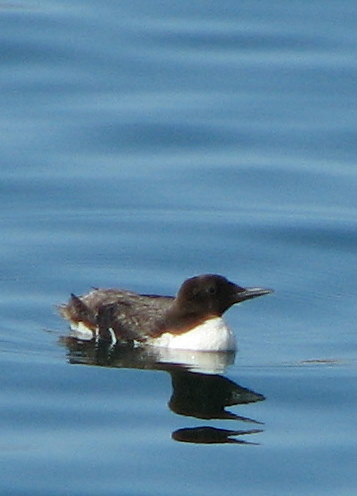
- Common murres eat several kinds of forage species, and though each bird is small, collectively, the species consumes an esitmated 175,000 tons of forage species each year. Creative commons photo by SGrace.
Sydeman doesn’t think we’re doing that in the California Current ecosystem: “Forage fish fisheries like the sardine fishery have existed alongside fisheries that target predators like salmon for a long time.” He does see aquaculture as a valid threat. “As salmon and tuna farms develop, we have to feed those fish something.”
But enough needs to be left in the ocean to sustain the many predators that feast on forage species. One of these predators is the common murre, a two-pound seabird that feeds on squid, anchovies, juvenile rockfish, and a host of other small creatures. One murre may not put a dent in the supply, but collectively the species consumes nearly 175,000 tons. That’s just one species of seabird.
“The needs of predators are substantial,” says Sydeman, adding that we need models to quantify those needs. Ideally, those models will incorporate the possible effects of climate change, too. Anthropogenic factors other than direct harvesting affect forage fish, including pollution and coastal development, but climate change may be the trickiest card in the deck, making an already variable system even less predictable.
“Forage fish are extremely responsive to normal climate variability,” says Sydeman. “Harvesting needs to be precautionary to mitigate the effects of climate change.”
Pleschner-Steele says harvesting is already precautionary. “I just wish we could get recognition for what we are doing–for the multiple levels of protection and management already in place.”
Progressive policies like the Marine Life Protection Act (which established Marine Protected Areas in California’s three-mile coastal zone) have helped California Current fisheries gain recognition as among the world’s most sustainable fisheries, including a 2009 article in Science that said current harvest rates in the California Current Ecosystem have declined to rates at or below the level required to ensure long-term sustainability.
Ticehurst acknowledges that management of West Coast fisheries is heading in the right direction and is gratified that recreational fishermen are making the connection between forage species and the rockfish they hope to reel in.
“We will continue to fight the battle to educate people,” he says.
AB 1299 has been amended four times since it was introduced in February. The Natural Resources Committee passed the bill by a 5-3 vote and sent it back to Appropriations. Follow the bill’s journey through the legislature at aroundthecapitol.com/Bills/AB_1299.
Further Reading
California Wetfish Producers Association
Darrell Ticehurst’s blog for Pacific Coast Sportfishing Magazine
California Dept of Fish and Game Overview of the Marine Life Management Act
Pacific Fisheries Management Council coastal fisheries management

.jpg)
